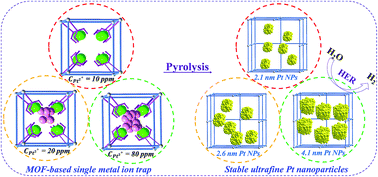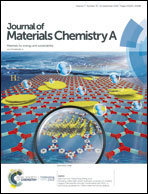Stable and size-controllable ultrafine Pt nanoparticles derived from a MOF-based single metal ion trap for efficient electrocatalytic hydrogen evolution†
Abstract
The rational design and controllable synthesis of stable multi-size ultrafine metal nanoparticles is a challenging task. Herein, we develop a general synthesis strategy for controlling the sizes of ultrafine metal nanoparticles using a single metal ion trap based on metal–organic frameworks (MOFs). By grafting ethylenediaminetetraacetic acid (EDTA) onto the inorganic nodes of MOF-808 by a solvent-assisted ligand exchange method, the post-synthesized MOF-based single metal ion trap (MOF-808-EDTA) materials can capture single Pt2+ ions at EDTA sites, while uncaptured Pt2+ ions will form various sizes of PtO2 nanoclusters inside MOF-808-EDTA pores as precursors. Upon pyrolysis, the sizes of ultrafine Pt nanoparticles can be effectively controlled in the range of 2.1–4.1 nm by adjusting the Pt2+ ion concentrations via both migration/coalescence and Ostwald ripening aggregation mechanisms. With the atomically distributed metal species precursors in the MOF materials, stable and size-controllable ultrafine metal nanoparticles can be prepared. Compared with commercial Pt/C (20 wt% Pt), the Pt nanoparticles with a size of 4.1 nm not only exhibit a lower overpotential of 42.1 mV at a current density of 10 mA cm−2 and a Tafel slope of 24.45 mV dec−1 but also have a higher stability although they have a lower amount of Pt (9.58 wt%). To the best of our knowledge, this is the first report on catalysts synthesized with only a single Pt component rather than alloys, having better HER performance than the commercial Pt/C catalyst. Using the same method, other ultrafine metal nanoparticles such as Pd, Ru, and Rh with controllable sizes have also been successfully synthesized. This indicates that the single metal ion trap MOF-based materials proposed in this work have great potential to serve as a general synthesis platform for preparing stable ultrafine metal catalysts with controllable sizes.



 Please wait while we load your content...
Please wait while we load your content...